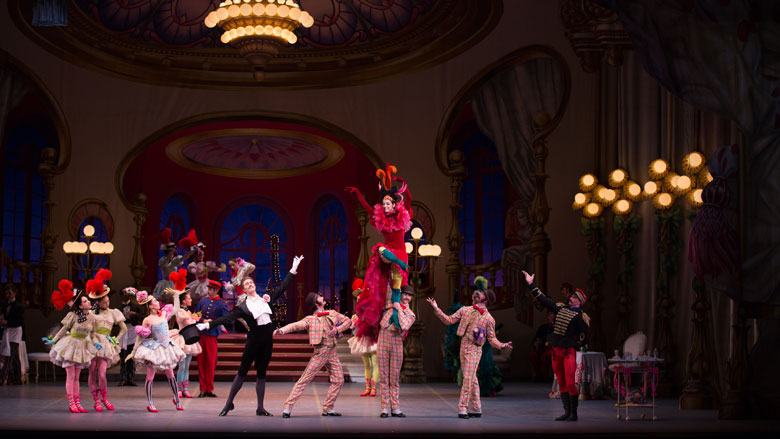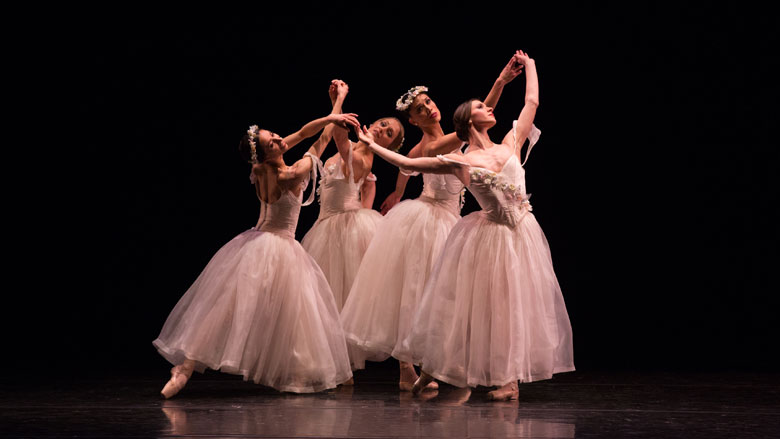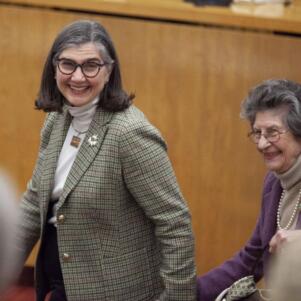The BLOG: Culture
Frills and thrills at Boston Ballet
Mary Hierholzer | March 19, 2016

Boston Ballet in Léonide Massine’s Gaîté Parisienne; photo by Rosalie O’Connor, courtesy of Boston Ballet
A French comedy and the powerhouse women of Boston Ballet shone on opening night Kaleidoscope last week. The four-piece program of 20th-Century choreographers showcased the company’s diverse skill-set, with especially stunning performances from the ladies. From Balanchine to the can-can, Kaleidoscope was too much fun to justify it being a Thursday night.
Principals Lia Cirio and Dusty Button started off the night, leading George Balanchine’s “Kammermusik No. 2” with Principal Dancers Paulo Arrais and Lasha Khozashvili and a chorus of eight men from the Corps de Ballet. The flexed feet, outstretched arms and neoclassical music probably pushed the boundaries of dance at its 1978 premiere, and it still presents dancers with challenging choreography. Cirio and Button brought character to their respective roles, complementing each other well. Cirio was a force to reckon with, intense and strong, while Button showed charm, sweetness and humor.
It was a stark change when the curtain rose upon four ballerinas in romantic white tutus. Squinting your eyes, the dancers looked like a Degas painting. But don’t compromise your gaze for too long because you’d miss out on the full effect of Leonid Yakobsen’s classical “Pas de Quatre.” Soloist Maria Baranova and Principals Erica Cornejo, Ashley Ellis and Cirio remained linked by holding hands for the mesmerizing first movement. It was an exploration of unified movement, not coincidentally.
According to a Boston Ballet promotional video, Yakobsen (1904-1975) premiered “Pas de Quatre” in 1971, when tension in Soviet Russia ballet spurred dancers to sabotage each other, even to the point of sneaking glass into their shoes. In response to the animosity, Yakobsen created this piece that required ballerinas to work together. The program notes describe that the choreography “creates an air of sisterhood and showcases the absolute coordination necessary to pull off the intricacies of dancing with continuously linked arms and connected hands.”
The women took turns leading their quartet, smoothly weaving between arms to melodies from Vincenzo Bellini’s Norma. Each dancer’s attitude was unique, both in the group and in their solos. Baranova enchanted with her elegant lines and controlled technique. Cornejo danced a delightful and energetic solo, mastering tricky pointe work with ease. Ellis captured the essence of a classical ballerina, pristine and smooth. Finally, Cirio returned with a compelling performance that managed to communicate both strength and softness.
The mood took a sharp turn for William Forsythe’s “The Vertiginous Thrill of Exactitude,” which was just that: a pure thrill, start to finish. Forsythe’s choreography set to the fourth movement of Franz Schubert’s Symphony No. 9 demanded Boston’s dancers to execute complicated, fast-paced steps. Principal Misa Kuranaga and Soloists Ji Young Chae and Seo Hye Han were a blur of green, spinning vigorously in their unconventionally flat tutus.

Boston Ballet in Leonid Yakobson’s Pas de Quatre; photo by Rosalie O’Connor, courtesy of Boston Ballet
With agile leaps and bright violet costumes, Principals John Lam and Arrais were in their element, a stunning presence onstage. Lam’s performance and partnering with Kuranaga was so masterfully detailed that it seemed as though he could have done it in his sleep. Incredibly, the dancers showed not a hint of exhaustion at the end of such an energetic performance.
But it was the last performance of the night that Boston audiences will not soon forget. Though it was arguably the piece that everybody was waiting for, nobody was prepared for the curtain to rise on Massine’s opulent “Gaîté Parisienne.”
The sights and ensuing humor were so spectacular that it was impossible to know where to look. But wherever your eyes settle, you won’t go wrong. The company looked like they just walked off of the Paris runway, decorated in the frills and bold patterns of Christian Lacroix costumes, each one more spectacular than the last. The Eiffel Tower glittered against a deep blue and pink sunset through bold red windows, centering a set painted like an elaborate French belle époque cartoon.
To name each dancer deserving of mention would be to list the entire bill: Soloist Patrick Yocum as the Dance Master, Second Soloist Bo Busby as the Duke and Principal Eris Nezha as the Baron all gave remarkable performances. The three Billiard Players, Soloist Paul Craig, Corps de Ballet member Matthew Slattery and Second Soloist Junxiong Zhao were excellent partners for the women (and, not to mention, hilarious).
The Corps de Ballet had many moments and strong women to boast: Brittany Summer and Rachel Cossar were divine as La Lionne and the Lady in Green. Ekaterine Chubinidze showed off some excellent solo turns. The men were comical and synchronized, and the women were flirtatious and worthy of praise in the can-can (the crowd couldn’t help but clap along to Offenbach’s infections tune). It was a team effort where every dancer was vital.
But two dancers whom it would be a crime to rob of attention are Soloists Anaïs Chalendard as the Glove Seller and Federico Fresi as the Peruvian. Incidentally, Chalendard’s role fit her like a glove. The French-trained ballerina put her elongated movements to good use, setting the scene with her confident and alluring presence. She is truly special. But Fresi ultimately stole the show. From the moment he burst onstage in a silky white suit and ridiculous mustache, he owned his role and commanded the whole theater’s attention with a good dose of slapstick humor.
The hype surrounding Kaleidoscope is more than justified. This was great opportunity for Artistic Director Mikko Nissinen to show off his dancers’ impressive repertoire, and his leading ladies are especially worthy of commendation for such memorable performances. At the end of the day, it’s hard to say who had more fun in Kaleidoscope; the crowd or Boston Ballet.
Boston Ballet will perform Kaleidoscope at the Boston Opera House through March 26. Tickets are available for purchase on Boston Ballet’s webpage.







